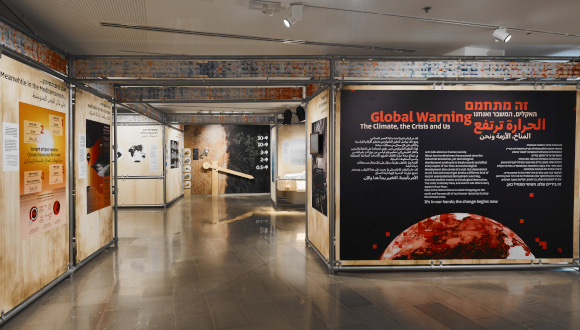New Steinhardt Museum exhibition focuses on climate change

"Global Warming: The Climate, The Crisis, and Us" opens to the public on July 21
Support Tel Aviv UniversityIn recent years the climate crisis has evolved from a scientific term to a tangible reality. The average temperature measured on the earth’s surface is rising, more and more temperature records are being broken in many places around the world, and we’ve experienced extreme weather events, ecological destruction and a negative impact on biodiversity. About two hundred years have passed since the Industrial Revolution, and technological development continues to accelerate and affect every facet of our lives. But technological advancement comes at a cost, since our dependence on oil, coal and natural gas is negatively impacting both the earth and us. The crisis is already here, and it’s everywhere.
The Steinhardt Museum of Natural History at Tel Aviv University presents a new, original exhibition, Global Warning: The Climate, the Crisis and Us. More information about the exhibition, which opened on July 21, 2021, can be found at the museum’s web site.
This exhibition presents diverse evidence of the climate crisis and its effects, in Israel and around the world, but emphasizes that we still have the opportunity to slow down the changes causing the crisis and reduce its impact on us and the environment; each and every one of us can do something to make a difference, to help slow down the change and minimize the impact of the crisis. The exhibition disentangles the complexity of climate change for the public, and shows how knowledge, involvement and passion regarding this issue, both as individuals and as a community, can promote significant change.
The establishment of this exhibition was guided by a broad, diverse team of scientists and professionals, who contributed up-to-date scientific knowledge and helped to adapt it for display in the museum. The scientific curator of the exhibition is Judi Lax, and the curator and experience designer is Hadas Zemer Ben-Ari.
The fruit of over a year of hard work at the museum and COVID-19 lockdowns, the new exhibition presents the most up-to-date scientific evidence in the field, including the effect of the crisis on us and on nature, in Israel and around the world, using interactive media, videos and an online, individual carbon footprint calculator, which was developed especially for the exhibition and adapted to Israel.
The exhibition offers close examination of what’s happening in the world today, and calls on all visitors to make a joint effort to slow down the climate crisis and expand public discourse on the issue. The exhibition also offers visitors simple suggestions for changing habits and lifestyles. Visiting the exhibition is also an act of change: raising awareness of the climate crisis and public discourse on the issue are important and essential for driving overall change. Thus, each visitor is part of the change, and can have an effect by simply sharing content and insights.
The exhibition will be on display in the Multipurpose Gallery at the museum and will also be integrated into the museum’s permanent exhibitions. In addition, as part of the exhibition, an interactive stand was set up to present the effects of the climate crisis on plants and animals; it is on display as part of the permanent exhibition, “The Web of Life”.
According to Professor Tamar Dayan, Chair of the Steinhardt Museum of Natural History, “The greatest challenging facing humanity today is the environmental challenge, and the most severe and irreversible challenge is unprecedented species extinction and ecosystem loss. Climate change on the earth poses a severe threat to humans — to economic, social and health systems — and it has and will have a negative impact on all ecosystems. We depend on ecosystems for our existence, thus this is a challenge that the world must respond to. Correct management of ecosystems will contribute to their stability and moderate climate damage to humans. Therefore, this is an emergency; we must take effective steps to deal with this global crisis.
“As a research museum, the Steinhardt Museum of Natural History monitors the changes in biodiversity resulting from environmental change, including changes caused by climate change, and uses these changes to predict future changes and their consequences,” Professor Dayan says. “Alongside the visitor experience at the exhibition, we also aspire to turn our visitors into agents for change, who will carry the message beyond the museum’s walls and recruit many others for this much-needed change.”
According to Alon Sapan, Director of the Steinhardt Museum of Natural History, “The museum places great importance on presenting data about the climate crisis and exposing this burning issue, despite its complexity, to as broad a public as possible, in order to place it at the center of public discourse here in Israel. The museum medium creates an opportunity to illustrate and demonstrate a complex reality and the processes causing it, alongside predictions for the future, while maintaining the visitor experience and encouraging curiosity. I hope that the exhibition will raise questions, but will also offer opportunities for changing personal habits.
“By deciding to produce an exhibition on the climate issue, the Steinhardt Museum in Tel Aviv joins the largest natural history museums around the world, which are also currently exercising their social and cultural obligation to inform the public and drive it to act, in order to change the conduct of the human species with respect to the entire planet,” Sapan adds.